Since high TOEFL scores are based on well-developed answer structures and overall comprehension, anyone with a good understanding of the test can reach their dream score! Let’s dive in to learn what the TOEFL is and how to strategically achieve your target score.
1. What Is the TOEFL?
The TOEFL is a 2-hour English proficiency test that’s widely accepted in 11,500 institutions around the world. TOEFL stands for Test of English as a Foreign Language and the test covers 4 sections: Reading, Listening, Speaking, and Writing. A good TOEFL score can range anywhere from 80 to 100, depending on what you need the score for.
The average for Ivy League universities in the United States often requires a 100 to 110 range for admissions, while nursing programs require anywhere between 80 to 100. Be sure to check with the institutions you intend to apply to for their minimum TOEFL score requirements. Once you take the TOEFL, your TOEFL score will be valid for up to 2 years.
If you’re curious about what the TOEFL 2023 test looks like, watch this overview:
2. TOEFL vs. IELTS
| TOEFL iBT | IELTS Academic | |
|---|---|---|
| Average cost (in the U.S.) | $220~$245 | $245~$255 |
| Length | 2 hours | 2 hours 45 minutes |
| Break time during test | None | None |
| Scoring | 0~120 | 0~9 |
| Sections | Reading, Listening, Speaking, Writing | Listening, Academic Reading, Academic Writing, Speaking |
| Test day | The whole test will be done on the same day | Listening, Reading, and Writing must be completed in order on the same day. Speaking may be taken at a different time and requires a separate appointment. |
| Testing location | At the testing center OR online with TOEFL Home Edition | At the testing center OR online* |
| Content | Commonly taken as a computer-based test, the TOEFL covers mainly academic subjects and 1~2 opinion-based questions. | Taken both as a paper-based test and a computer-based test, the IELTS covers academic, opinion-based, and problem-solving questions. |
| Sections in testing order and question types | Reading 1. Factual 2. Negative Factual 3. Inference 4. Rhetorical Purpose 5. Vocabulary 6. Reference 7. Sentence Simplification 8. Sentence Insertion 9. Summary 10. Fill in the Table | Listening 1. Multiple choice 2. Matching 3. Plan/Map/Diagram labeling 4. Form completion 5. Note completion 6. Table completion 7. Flow-chart completion 8. Summary completion 9. Sentence completion 10. Short answer questions |
| Listening 1. Gist (Content) 2. Gist (Purpose) 3. Detail 4. Function 5. Attitude 6. Organization 7. Connecting Content 8. Inference | Reading 1. Multiple choice 2. Identifying information 3. Identifying the writer’s views/claims 4. Matching information 5. Matching headings 6. Matching features 7. Matching sentence endings 8. Sentence completion 9. Summary completion 10. Note completion 11. Table completion 12. Flow-chart completion 13. Diagram label completion 14. Short-answer questions | |
| Speaking 1. Independent speaking response 2. Integrated speaking response | Writing 1. Graph/ table/ chart/diagram summary essay 2. Explain a solution to a problem | |
| Writing 1. Integrated essay 2. Academic discussion | Speaking Interview format, either with a test examiner on-site or via video call online |
Check the admissions page of the university/institution website you’re intending to apply for and check which type of IELTS test scores they accept.
Already have a TOEFL or an IELTS score? The official TOEFL website provides a score comparison chart.
3. What Are TOEFL Dummy Questions?
On the Reading and Listening sections of the TOEFL, the test makers may add an extra set of questions to test new material. Don’t worry, you’ll get extra time to finish the dummy question set. Although dummy questions do not count toward your grade, there is no way to know which question set is the dummy. So make sure to give your best effort for all questions in each section!
4. TOEFL Section Study Tips
These are the 4 sections of the 3-hour TOEFL exam. Here are some tips to help you start your study journey.
TOEFL Reading Section Tips

The reading passages given in the TOEFL Reading section are not designed to be read completely. If you read the whole passage first, you will run out of time. To complete the whole section, make sure to read the question first. You’ll encounter questions that ask you about a specific paragraph often (ex: “According to paragraph 5…”). You can save time by referring to specific paragraphs instead of reading the whole passage. If you’d like to know more about the TOEFL 2023 Reading section, watch this overview:
Here are more practical tips for improving your TOEFL Reading section score.
TOEFL Listening Section Tips

Once the conversation or lecture audio stops in the TOEFL Listening section, you must rely on your notes to answer each multiple-choice question. This means that as soon as the conversation or lecture starts playing, you need to be ready to take accurate notes — efficiently. To help you write better notes, we’ve prepared this TOEFL Listening section note-taking guide video:
Learn more about TOEFL Listening in 5 minutes:
Here are more practical tips on how to improve your TOEFL Listening section score.
TOEFL Speaking Section Tips

Known as the hardest section of the TOEFL, the speaking section asks you to speak about your opinion on a topic OR summarize the given information from reading a passage and listening to a lecture or conversation. It’s a section that tests your ability to read, understand, formulate assertions, and then express them as well-structured responses. The best way to tackle the TOEFL Speaking section is to split your practice by question type: Independent and Integrated.
The independent question type asks you to express your opinion on a topic. Often, you’ll have to choose whether you agree or disagree. Make sure to pick 1 position — I agree OR I disagree — to guarantee a high-scoring answer.
As for the integrated question, you’ll be given a reading passage and a lecture or conversation audio about the same topic. Just like the listening section, your note-taking skills will need to come in handy. In the integrated question, do NOT include your personal opinion. It will deduct points from your score. Instead, you must stick to the information given from the reading passage, lecture, and/or conversation only. If you’d like to know more about the TOEFL Speaking section, watch this overview video:
To master your speaking responses, check out these Speaking section tips and templates.
TOEFL Writing Section Tips

Although there are only 2 questions in the TOEFL Writing section, each takes 20 and 30 minutes to complete. This is the longest time per question you’ll get to answer a question throughout the entire TOEFL exam. Since there’s more time in this section to write your answer, you have to make sure your answer fulfills the rubric’s standards. After reading the rubric, you’ll know exactly what a perfect score on the TOEFL Writing section looks for.
Now, I highly recommend looking at high-scoring model answers like these to get familiar with the type of answer essays you’ll have to write:
If you’d like to learn more about the TOEFL Writing section, watch this overview video:
5. 3 Mistakes to Avoid on the TOEFL
Knowing the structure of the TOEFL is half the battle. Once you learn what you can expect to see on your TOEFL exam, you’ll be well prepared to improve your score. Here are 3 common mistakes that will always lead to a disappointing score:
1.) Taking a Full Practice Test Once Before Your Exam
When we say full practice test, we mean the full, 2-hour practice test that simulates the TOEFL. ETS sells testing booklets with 5 full-length mock tests, each costing around $28 to $38. It’s either a paper book or e-book format and does not grade your speaking or writing skills. We made TestGlider to solve this problem.
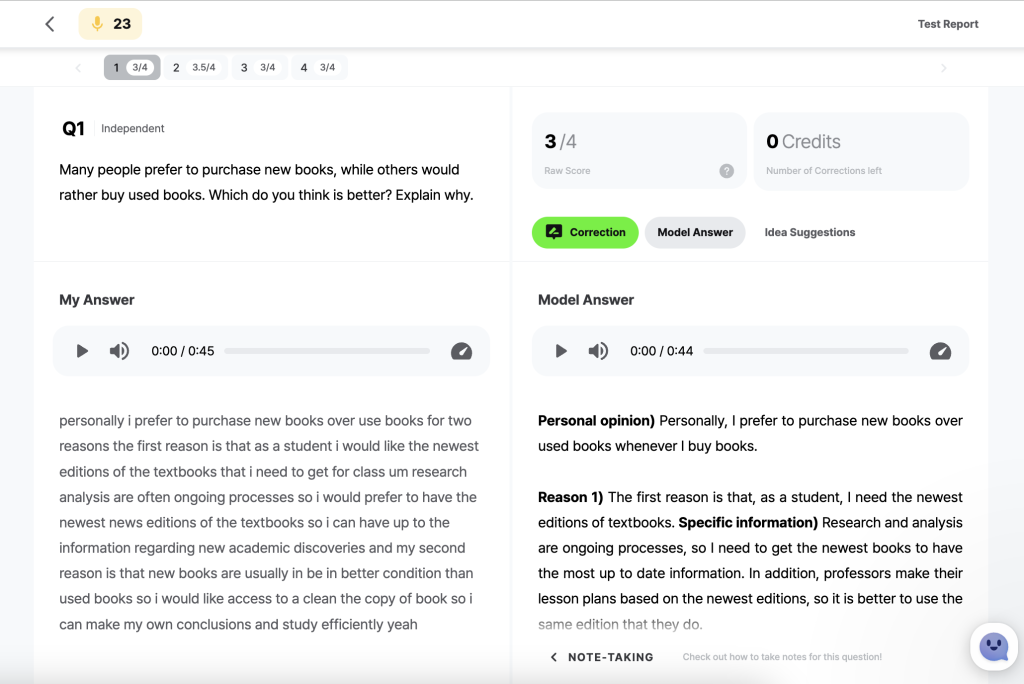
We have 12 Full Test sets that all provide unlimited grading. You can practice as many times as you need to nail that perfect speaking response before you take the actual TOEFL.
2.) Depending On Your Casual English Skills
The TOEFL is not a basic English exam. If you do not know the test structure, time limits, or question types, you are more likely to hurt your score. This usually means that you’ll have to purchase the test again… and again… until you get the score you want.
However, the TOEFL is a pricey test. Learning the test structure can help you ace your exam on your first try. To get a high score on your TOEFL exam, you’ll have to know what kinds of vocabulary you’ll be dealing with and get a hang of the lecture/conversation audio so it won’t take you by surprise. Again, the TOEFL is NOT a basic English test. It’s an English test that evaluates your ability to understand, speak, and behave accordingly in a campus environment. This means you’ll be reading about the scientific origins of medical diagnoses you’d never heard of. Much like any standardized test, the TOEFL will ask you to answer questions — both multiple-choice and free responses — with the given information.
The key to improving your score is knowing how to answer each TOEFL question type. To help test-takers with this problem, we provide in-depth answer explanations for every question on TestGlider.
You can compare your answer to top-scoring model answers and see how other users have answered the same question on the “Review*” page.
*You must be logged into your TestGlider account to see the Review page. After completing a Full Test or a section test, click on the test set (i.e. Apple) and you’ll find the “Review” button next to each test you’ve completed.
3.) Not Timing Your Practice Sessions
If you practice without a timer, you won’t be able to answer in time. For example, did you know you only have an average of 1.75 minutes to answer TOEFL Reading questions? Knowing how much time you need to solve each type of question can help you distribute your time efficiently. Make each of your practice sessions count with accurate timing! TestGlider practice tests are all timed. We’ll keep track of your progress so you don’t have to.
6. 6 Fastest TOEFL Preparation Methods
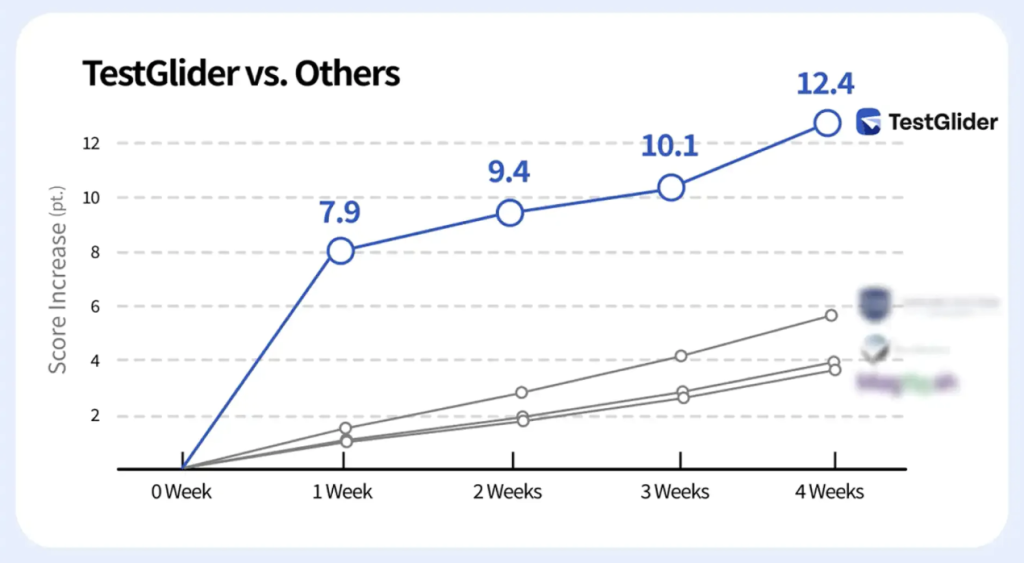
One of the most common questions we get from TestGlider users is: “I have my TOEFL exam in a few weeks! What’s the best way to improve my score?”
It’s often difficult (and expensive) to purchase a practice test book and start preparing in such a short time. Other online TOEFL test prep sites will ask you to imagine a scenario, record your answer and do nothing with it, or even pay a hefty price for professional tutor feedback.
That’s the old way to study for the TOEFL (and it takes forever).
All TOEFL practice tests are graded automatically in 2 minutes — only on TestGlider. Here’s how you can use TestGlider to reach your dream goal in the quickest way possible before your TOEFL exam date:
1.) Take a Full Test
Even if it might be scary to tackle the 2-hour test, go ahead and complete a Full Test. TestGlider grades your first Full Test for free so you can see where you need to improve the most.
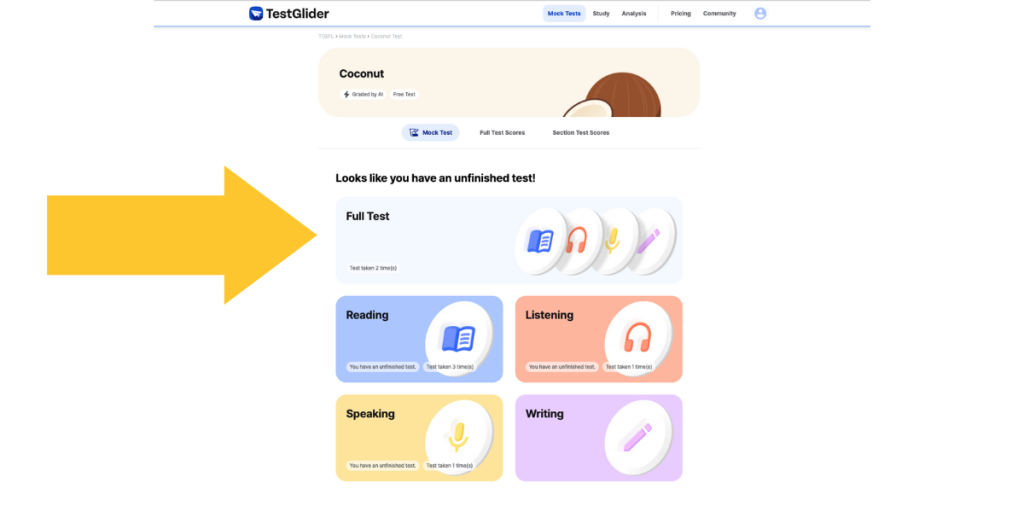
2.) Review Your Answers
See the answer explanation and feedback for every test you take with “Review.” The TOEFL answer explanations are designed to help you understand how to avoid incorrect answer choices, so make sure to review your answers. For the Speaking and Writing section reviews, read “Model Answer” for high-scoring answer examples.
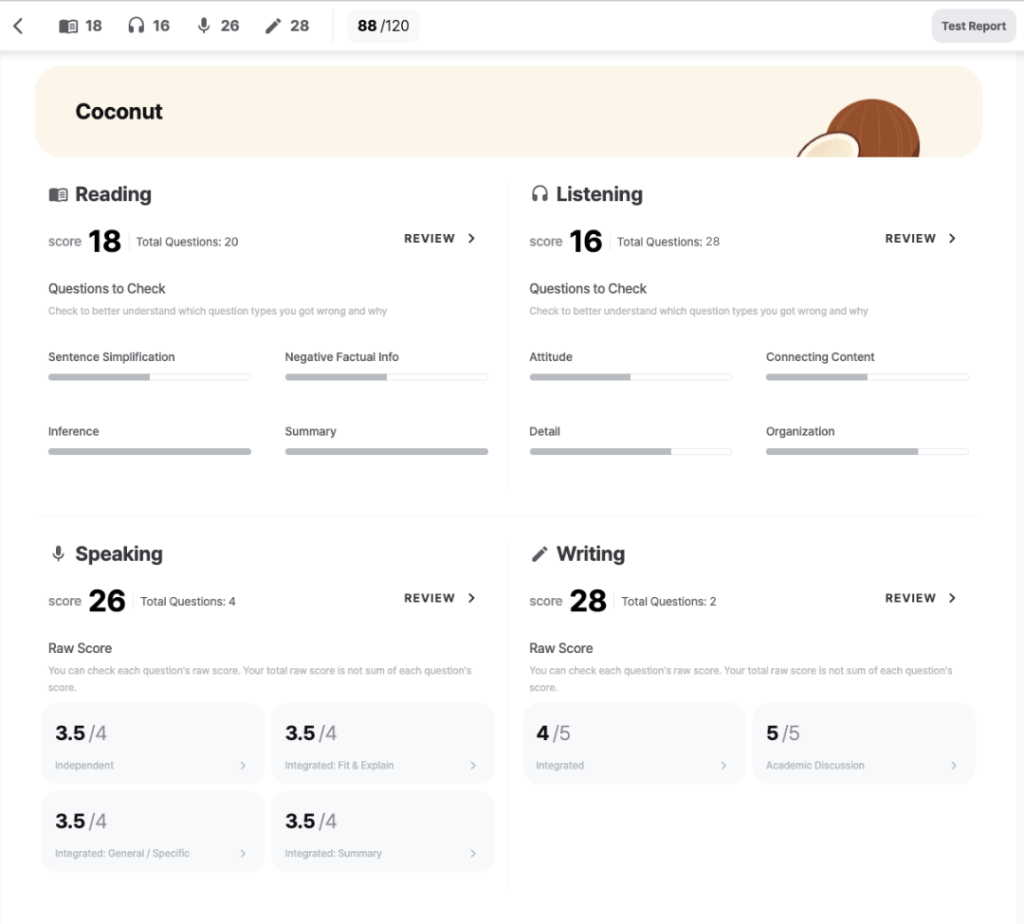
3.) Analyze Your Practice Questions
Head over to the “Analysis” page to learn which section and question type you struggle with the most. You can also see how your skills compare to others in the “Results by Section” chart. It’s time to choose which section you want to improve on first.
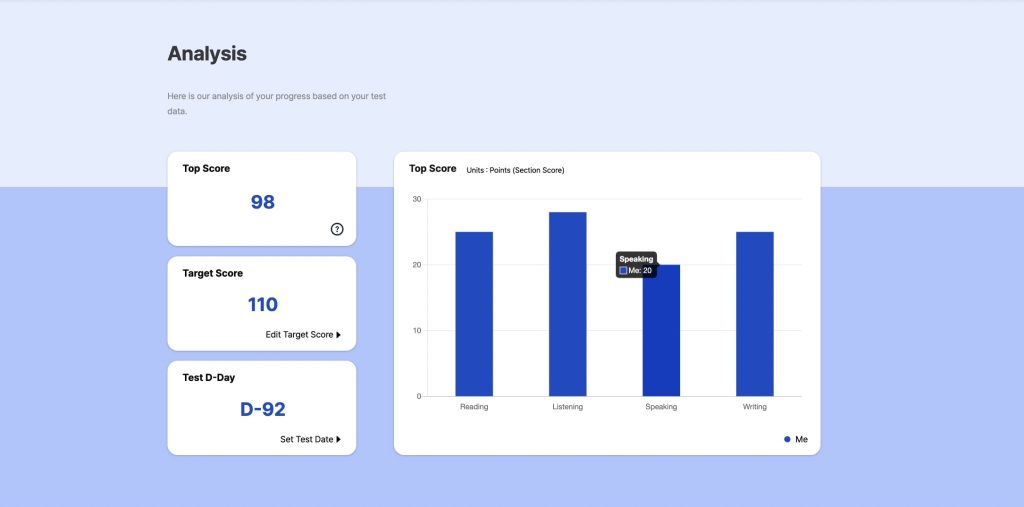
4.) Refer to Study Tips
Join the TestGlider blog and get the latest TOEFL Speaking and Writing answer templates. There are plenty of tips about answering each Reading and Listening question type. You can also find the Speaking and Writing answer templates in our blog posts.
5.) Take a Section Test
Now that your Analysis page has shown you where to improve, take a section test and see your score improve. Section tests will help you focus on improving one section at a time. Once your score range improves toward your goals, move on to the next section.
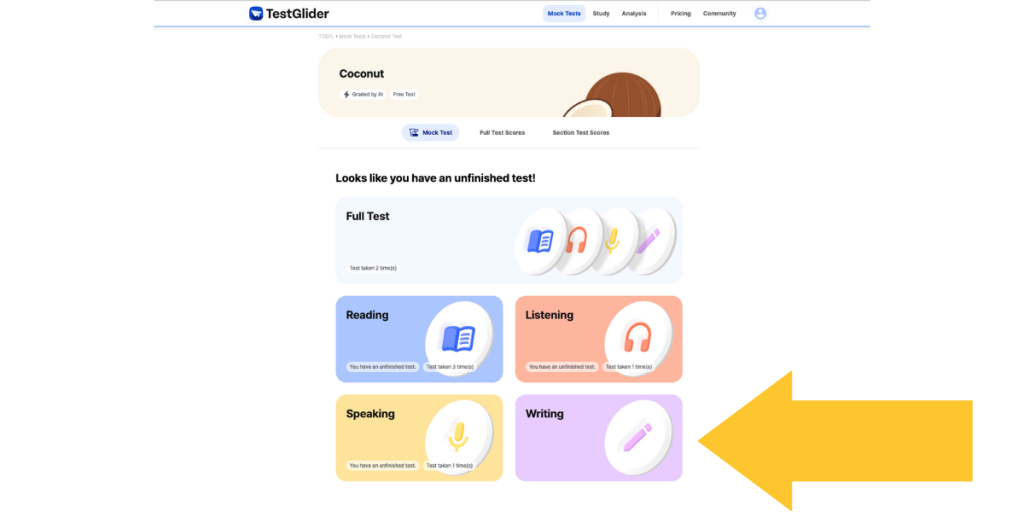
6.) Practice with Recommended Questions Every Day
Take Recommended Questions and get your TOEFL practice in for the day. Take one question at a time and take as many questions as you need. If practicing an entire section feels overwhelming, click on Recommended Speaking Questions to practice speaking just 1 response at a time. You’ll get fast grading and review feedback all the same. You can choose whichever section you’d like to practice with.

